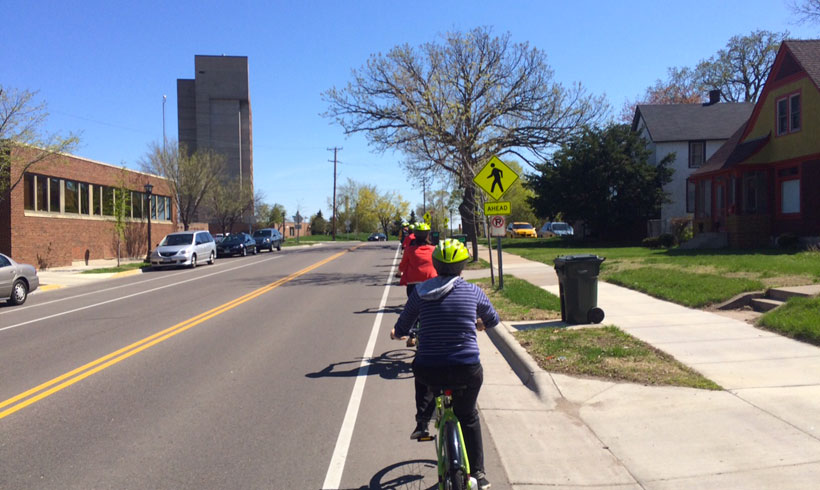Sierra Club Executive Director Michael Brune calls the climate agreement in Paris "a turning point for humanity. For the first time in history, the global community agreed to action that sets the foundation to help prevent the worst consequences of the climate crisis while embracing the opportunity to exponentially grow our clean energy economy."
Paris marks the beginning, not the end of the work that must be done locally and globally to address climate change. 2016 is an opportunity to move Transportation Forward to cut Minnesota's greenhouse gas emissions. Dave Van Hattum of Transit for Livable Communities connects the dots for us. Below is a repost from his original article.

Transit emits a fraction of the pollution of driving alone. Bicycling and walking? Emissions free.
On December 12, the 2015 United Nations Climate Change Conference in Paris, France, culminated in a historic, global agreement to reduce climate change. With these international talks now concluded, it is urgent that all nations move from meetings and rhetoric to bold action.
The latest data show transportation contributes 27 percent of all greenhouse gas (GHG) emissions in the U.S. (25 percent in Minnesota), second only to electricity production (at 31 percent nationally). That means, going forward, our transportation systems and habits will have a major role to play either in reducing climate change or in exacerbating the problem.
A Sustainable System
To reduce climate change and carbon pollution, it is imperative that we design cities and transportation options with greenhouse-gas reduction and energy efficiency as guiding principles. Doing so means greatly expanding transit, bicycling, and walking—an approach that, fortunately, is exactly what consumers and employers are demanding.
As in other sectors of the economy, creating a more energy-efficient and less carbon-emitting transportation system has synergistic benefits—for environment, health, equity, and sustained economic growth. For example, when we design cities and roads so that sustainable options such as walking, bicycling, and public transit are more convenient, we provide affordable transportation options for those who need them most. When increases in transit and active transportation mean less smog, we reap the benefits of fewer health problems and lower health care costs—particularly for people of color and low-income residents who, disproportionately, live close to areas of high car traffic.
Bold Leadership
Climate change is a global problem, with serious implications at the national, state, and local levels. Ensuring transportation is part of the solution requires strong leadership from local, state, and national politicians, from religious leaders, and from concerned citizens.
As President Obama acknowledged, “Even if all the initial targets set in Paris are met, we’ll only be part of the way there when it comes to reducing carbon from the atmosphere. So we cannot be complacent. . . .” Still, he went on to say that the Paris Agreement “will mean less of the carbon pollution that threatens our planet, and more of the jobs and economic growth driven by low-carbon investment. Full implementation of this agreement will help delay or avoid some of the worst consequences of climate change, and will pave the way for even more progress, in successive stages, over the coming years. . . . I believe this moment can be a turning point for the world. We’ve shown that the world has both the will and the ability to take on this challenge.”
In the lead-up to the Paris talks, other world leaders spoke out on climate change, transportation, and the importance of crafting new strategies to cut greenhouse gas emissions. For example, in his powerful encyclical on climate change, the Pope called out the importance of city design and transportation options, noting that “…the quality of cities has much to do with systems of transport. Many specialists agree on the need to give priority to public transportation.” Without delving into policy prescriptions, the Pope also highlighted the need for substantial improvements to transit to address “undignified conditions due to crowding, inconvenience, infrequent service, and lack of safety”—a position consistent with his critiques of the current inequities within and among nations.
From Policy to Action
Turning to federal policy, the new EPA Clean Power Plan creates the first regulations on carbon emission from power plants and looks to states to customize programs and policies to local opportunities. Unfortunately, however, the plan offers no comparable strategy for the transportation sector.
In contrast, the Minneapolis Climate Action Plan prominently incorporates advancing multimodal transportation as a key strategy for reducing citywide GHG emissions 30 percent by 2025. Commitments include:
• Constructing 30 miles of on-street, protected bicycle facilities
• Raising the bicycle commute mode share to 15 percent
• Helping double regional transit ridership
• Supporting safe, walkable neighborhoods
Curbing climate change will take contributions from all sectors of the economy. In the transportation sector, cleaner cars and cleaner fuels will help, but aren’t sufficient on their own. Decisive action to advance transit, bicycling, and walking is essential.
Knowledge of which modes of transportation will reduce greenhouse gas emissions is not new or to be determined. But we are at a turning point. In our communities, states, and countries, it is time not only to talk about increasing transit, bicycling, and walking, but to actually invest in and implement those options for a more sustainable future.